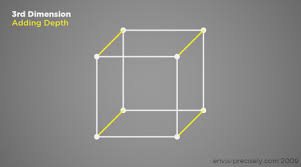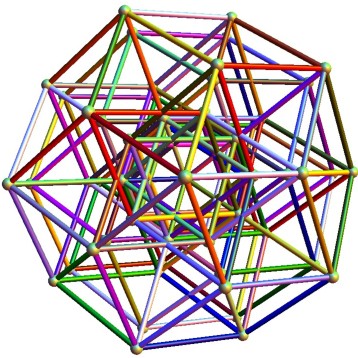Einstein recognized four dimensions, length, width, height and space-time. Since our eyes only see three in three dimensions (they cannot see space and time) comprehending the additional dimensions is both difficult and theoretical. Modern scientific theories call for at least ten dimensions, possibly as many as twenty-six or even an infinite number of dimensions. Though there is little agreement among scientists as to the natures of the additional dimensions, they are confident that there are more than four. Ancient Vedic texts speak of sixty-four dimensions long before modern science and mathematics was envisioned.
In zero dimension there are no measurements, but the zero also contains the point or the dot. It is the zero point. No numbers are needed to identify its position. The point is infinite in that it is present everywhere at once with no time, spacial measurements or observation needed. Zero dimension is thus infinite, as is the first dimension of the point.

The first dimension gives birth to the line. The line contains an infinite number of points. The line is symbolic of the future. The awareness inherent in the zero dimension creates a symbolic future, that forms a trajectory. Two dots are needed to define a line. Any other of the infinite dots on that line can be located on that line using one number. We can observe the distance to the second dot to the zero dot by using the distance between them as a unit of measurement. On a ruler, the first dots can be at 0 and the second dot is at some measurable length from the 0.
The second dimension is the plane. It contains an infinite number of straight lines. The second dimension represents the present or the now. We need two numbers to identify a point on a plane. Mathematicians call these the ‘x’ and the ‘y’ axis. The illustration represents four dots connected on a plane.

The third dimension is where energy observes itself and congeals into matter. This is the plane where thought and mind comes into play. To understand this, we need to realize that thought and mind are universal entities, not simply products of organic nervous systems. We need to understand that awareness and the unconscious mental processes are essential to the manifestation of actuality itself.
The third dimension is the plane where awareness observes the flatness of the first two dimensions and projects it into objects and events. In the third dimension, three numbers determine the distance of an object in space. These are usually called ‘x,’ ‘y’ and’ z’. The third dimension is observed from above the plane. The operating word here is ‘observed’. Without the unconscious awareness observing an object from above, there can be no third dimension and no object to observe.

The fourth dimension is space-time. This is the dimension that we live within. Four numbers are needed to place an object in space-time. Three of these numbers set the position in space, and one of the numbers give duration for setting the time. We live in a four dimensional world. The fourth dimension is the gateway to universal formation. Space-time is the unification of time and space as a four-dimensional continuum as in Minkowski space, the mathematical setting for special relativity.

The fifth dimension is where possibility begins. The fifth dimension begins the building of universal imagination. Images-in-action appear in this dimension, as unconscious awareness begins to imagine other possibilities and other possible events and different potential worlds.
A five-dimensional space is a space with five dimensions. If interpreted physically, that is one more than the usual three spatial dimensions and the fourth dimension of time used in relativitistic physics. It is an abstract which occurs frequently in mathematics, where it is a legitimate construct. In physics and mathematics, a sequence of N numbers can be understood to represent a location in an N-dimensional space. The geometry of the fifth dimension studies the invariant properties of such space-time, as we move within it, expressed in formal equations.
See: http://www.huffingtonpost.co.uk/henryk-frystacki-phd/discovery-of-the-fifth-dimension_b_2858709.html

Six-dimensional space is any space that has six dimensions, that is, six degrees of freedom, and that needs six pieces of data, or coordinates, to specify a location in this space. There are an infinite number of these, but those of most interest are simpler ones that model some aspect of the environment. Of particular interest is six-dimensional Euclidean space, in which 6-polytopes and the 5-sphere are constructed. Six-dimensional elliptical space and hyperbolic spaces are also studied, with constant positive and negative curvature.
See: https://en.wikipedia.org/wiki/Six-dimensional_space

Beyond the fifth dimension, dimensions are imperceptible to our senses. They are highly theoretical, mathematical in nature. That is to say, equations can describe them but we cannot see them.
The existence of extra dimensions is explained using the Calabi-Yau manifold, in which all the intrinsic properties of elementary particles are hidden. If the extra dimensions are compacted, then the extra six dimensions must be in the form of a Calabi–Yau manifold (shown below). While imperceptible as far as our senses are concerned, they would have governed the formation of the universe from the very beginning. Hence why scientists believe that peering back through time, using telescopes to spot light from the early universe (i.e., billions of years ago), they might be able to see how the existence of these additional dimensions could have influenced the evolution of the cosmos.

Seven-dimensional space in mathematics, is a sequence of n real numbers can be understood as a location in n–dimensional space. When n = 7, the set of all such locations is called 7-dimensional space. Often such a space is studied as a vector space, without any notion of distance. Seven-dimensional Euclidean space is seven-dimensional space equipped with a Euclidean metric, which is defined by the dot product.
More generally, the term may refer to a seven-dimensional vector space over any field, such as a seven-dimensional complex vector space, which has 14 real dimensions. It may also refer to a seven-dimensional manifold such as a 7-sphere, or a variety of other geometric constructions.
Seven-dimensional spaces have a number of special properties, many of them related to the octonions. An especially distinctive property is that a cross product can be defined only in three or seven dimensions. This is related to Hurwitz’s theorem, which prohibits the existence of algebraic structures like the quaternions and octonions in dimensions other than 2, 4, and 8. The first exotic spheres ever discovered were seven-dimensional.
See: https://en.wikipedia.org/wiki/Seven-dimensional_space
Another theory about the seventh dimension is that it grants access to the possible planes that start with different initial conditions and other points in space-time than our own. A point in the seventh dimension consists of all the possible worlds that start with the different initial conditions from our own space-time and leads to all the possible endings to which such an initial condition can possibly go. In the fifth and sixth dimensions, the initial conditions were the same as our own space-time and subsequent actions and events were different. In the seventh dimension everything is different from the very beginning of time.
See: http://www.universetoday.com/48619/a-universe-of-10-dimensions/
Eight dimensional space, in mathematics, is a sequence of n real numbers can be understood as a location in n–dimensional space. When n = 8, the set of all such locations is called 8-dimensional space.
Often such spaces are studied as vector spaces, without any notion of distance. Eight-dimensional Euclidean space is eight-dimensional space equipped with a Euclidean metric, which is defined by the dot product.
Generally the term may refer to an eight-dimensional vector space over any field, such as an eight-dimensional complex vector space, which has 16 real dimensions. It may also refer to an eight-dimensional manifold such as an 8-sphere, or a variety of other geometric constructions. See: https://en.wikipedia.org/wiki/Eight-dimensional_space
The ninth dimension contains all the possible universes and histories whether or not they shared the same starting point in space-time. The ninth dimension includes all the possible laws of physics and initial conditions.
The tenth dimension is the point in which everything possible and imaginable is contained. It contains the history and records of all that has ever existed.
See: http://www.universetoday.com/48619/a-universe-of-10-dimensions/
THIS BOOK IS FREE FROM AMAZON
The above is a sample chapter from the book Nothing Is Real: A metaphor for greater ideas. Not all the chapters are this complex and obtuse. The majority of the essays and articles are written in easy to understand prose. Free samples available and no cost review copies are available upon request from the author.

Infinity precipitates all things. Nothing becomes real, though nothing is real. Once experience begins there is no stopping it. Once movement defines space and contains enough duration to be felt, an entire universe is born.
http://www.amazon.com/dp/B01AU3C3CY
http://www.amazon.co.uk/gp/product/B01AU3C3CY?ref_=cm_rdp_product
http://www.smashwords.com/books/view/609430
https://itunes.apple.com/us/book/nothing-is-real/id1076006346?mt=11
hello, can you let me know which “ancient vedic texts” specifically mention 64 dimensions, thanks much~
LikeLike
DIMENSIONS OF UNIVERSE
According to vedic physics, space inside our universe is multi – dimensional. There are 64 main dimensions and each dimension is further divided into many sub-dimensions. Since the inhabitants of earth can perceive 3 dimensions, their senses have no access to many other realms of universal reality!!
It is said that through the ancient process of yoga ( specifically kriya yoga ) , one can obtain access to many other dimensions. When a yogi obtains access to other dimensions, he can perform unusual activities!
A yogi can achieve 8 mystical perfections. Each perfection gives him access to 8 additional dimensions. Thus by achieving all 8 perfections, a yogi obtains access to all the 64 (8*8) dimensions making his body unaffected by space time bound physical laws!
Excerpts taken from COMPARATIVE COSMOLOGY by AKIF MANAF J.
LikeLike